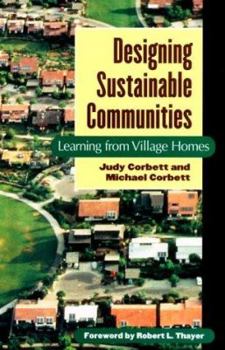Designing Sustainable Communities: Learning from Village Homes
The movement toward creating more sustainable communities has been growing for decades, and in recent years has gained new prominence with the increasing visibility of planning approaches such as the New Urbanism. Yet there are few examples of successful and time-tested sustainable communities. Village Homes outside of Davis, California offers one such example. Built between 1975 and 1981 on 60 acres of land, it offers unique features including...
Format:Paperback
Language:English
ISBN:1559636866
ISBN13:9781559636865
Release Date:December 1999
Publisher:Island Press
Length:254 Pages
Weight:0.79 lbs.
Dimensions:0.5" x 5.9" x 9.0"
Customer Reviews
3 ratings
THE STORY OF THE "VILLAGE HOMES" IN DAVIS
Published by Thriftbooks.com User , 14 years ago
The Village Homes community in Davis, California was designed by wife/husband team of Judy and Michael Corbett (and was heavily influenced by Howard's Garden City proposals, as well as the "greenbelt" communities in Maryland). Its keyword is "sustainable design"----that is, designing the community in such a way that it does not damage the environment, or consume nonrenewable resources. Begun in 1972, houses and apartments in this "garden village" are built to conserve energy and to utilize solar technology where possible, promote natural drainage of rainfall, have large open spaces for residents, feature "edible landscapes" (foliage such as fruit that can be picked for free by residents), and a sense of "community" promoted by the large number of public projects (such as building a playground for children). The authors begin by saying, "When we set out to design and build Village Homes in 1972, it seemed unlikely that we would be successful. We had no financial assets and no track record in development.... Luck was on our side. It took a great deal of tenacity and perseverence, but in the end we were able to overcome multiple obstacles and build Village Homes." This book details the struggle, and offers perceptive comments on both Village Homes, and similar community design movements. Ironically (and unfortunately), despite the ultimate financial success of the community (their homes have probably the highest resale value in Davis), there have not been other similar-sized or larger communities created based on the Village Homes model. The authors note that "Over time, houses in Village Homes have been growing increasingly less affordable. Over a twenty-year period, the community's reputation has changed from 'that hippie subdivision' to 'the most costly place per square foot to live in Davis.'" They also note that "The shopping center serves as a place to purchase goods and services, but ... it fails to function as a town center for the area it serves.... Aside from a few restaurants, there is little or no space for leisure or socializing. There are no plazas or civic spaces." This 2000 book will be of considerable interest to those interested in intentional communities, ecovillages, permaculture, environmentalism, the New Urbanism, etc.
A good read for those interested in green living
Published by Thriftbooks.com User , 15 years ago
This description of a well-designed eco community is useful on several fronts: 1) it mentions several sustainable communities in case you are looking for a better place to live; 2) It tells the realistic story of the challenges involved in creating a sustainable community, in case you are thinking of starting such a community; and 3) It makes an easy and inspiring read.
Sustainable Communities
Published by Thriftbooks.com User , 24 years ago
Judy and Michael Corbett have written a brief and thoughtful, not to mention well-informed book on the subject of designing and building sustainable communities. The various chapters on the history of their subject, on their seminal and justifiably respected community in Davis, CA, and on elements of the planning process and the integration of real estate pragmatics with environmental ideals will serve as both a user-friendly introduction for lay readers and a handy reference for professionals looking to expand their horizons. The writing is clear and uncomplicated, the design of the book is simple and straightforward, and there is the nice sense throughout that it has been put together by people who know wherof they speak. One complaint: it's unclear why a paperback published by a non-academic press would be priced a bit high but it is unfortunate, as it will serve to prevent this book from reaching the broader audience it deserves.






